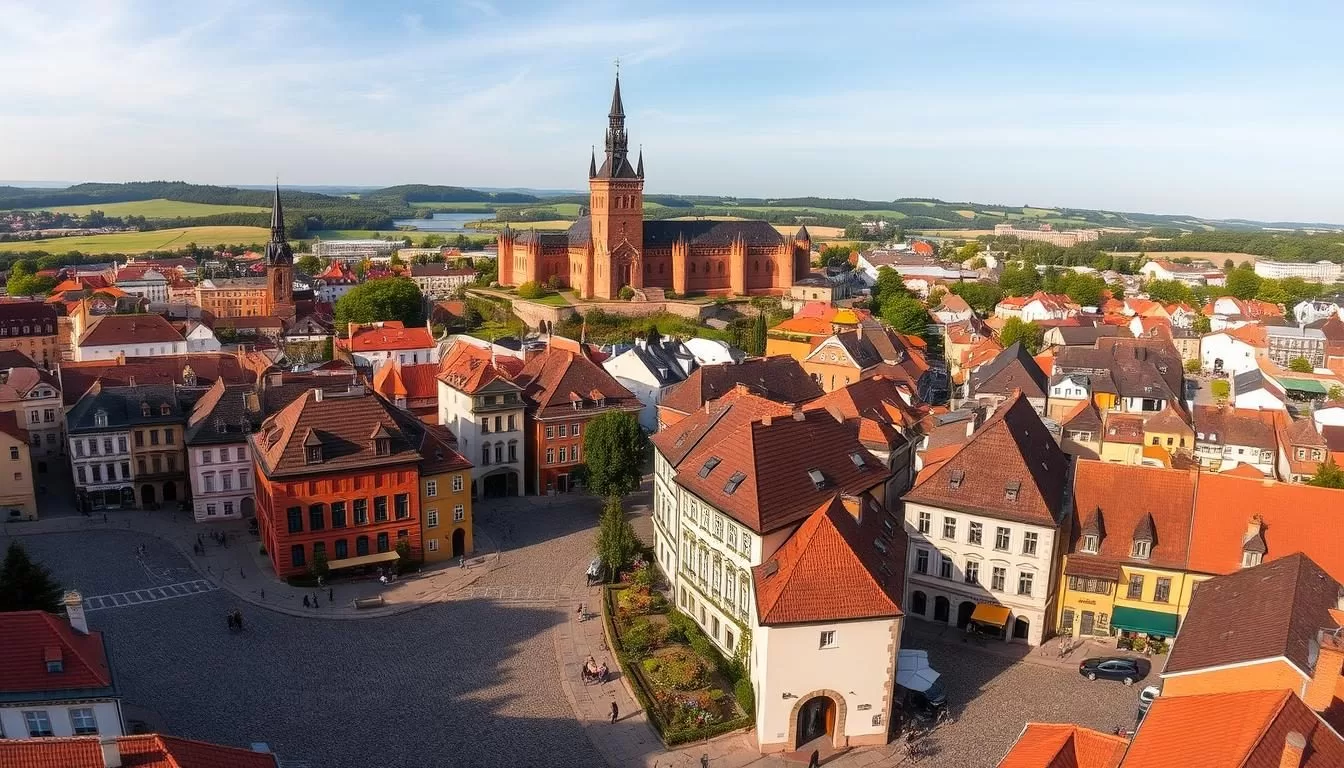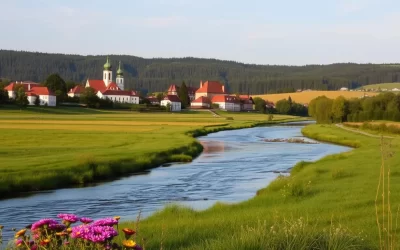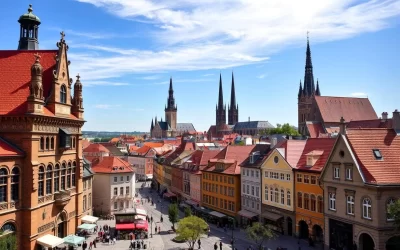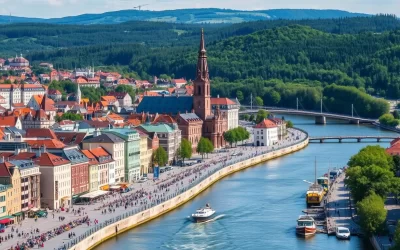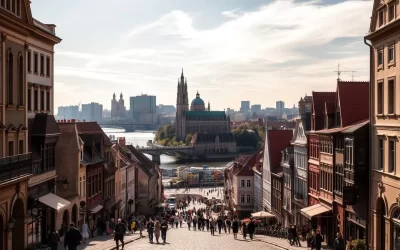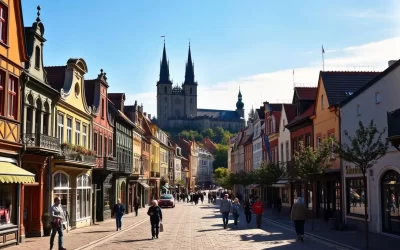Are you looking for a place that combines rich history with vibrant culture and natural beauty? Look no further than the charming city nestled in Eastern Poland. With 700 years of tradition, this destination offers a unique blend of historical attractions, cultural experiences, and culinary delights.
This city is known as the “City of Inspiration” where different cultures and religions have coexisted for centuries, making it a fascinating place to explore. You can wander through its well-preserved Old Town, visit historic religious sites, and enjoy the local cuisine without the crowds of more popular tourist destinations.
Our guide will take you through the must-see attractions and hidden gems, helping you plan your perfect visit to this Eastern Poland gem.
Discovering Lublin: Poland’s Hidden Gem
With its rich past and vibrant present, Lublin is a gem waiting to be explored. As you wander through its streets, you’ll discover a city that has been shaped by its strategic location between East and West Europe, making it a multicultural hub where Polish, Jewish, Ukrainian, and other cultures have flourished together.
A Brief History of Lublin
Lublin’s history dates back to medieval times, and its significance grew over the centuries, particularly during its golden age as a trade center. One of the most pivotal moments in Lublin’s history was the signing of the Polish-Lithuanian Union in 1569, creating one of Europe’s largest states at the time. This event not only highlighted Lublin’s importance but also contributed to its rich cultural heritage.
Throughout the years, Lublin has survived various conflicts and occupations, yet it has managed to preserve much of its architectural integrity. The city’s history is palpable as you walk through its streets, with over 110 monuments concentrated in just 1 square kilometer of the Old Town, making it one of Poland’s most authentic historical places.
- Trace Lublin’s evolution from its medieval origins to its modern-day significance.
- Explore how Lublin’s strategic location influenced its development as a multicultural city.
- Highlight significant historical events, such as the Polish-Lithuanian Union.
Why Lublin Deserves Your Attention
Despite its rich cultural offerings and historical significance, Lublin remains relatively undiscovered by international tourists. This makes it an ideal place for those seeking a more authentic Polish experience, away from the crowds that flock to more popular cities like Krakow or Warsaw.
Lublin offers a unique blend of historical landmarks and contemporary cultural activities, thanks to its vibrant university life and growing arts scene. Visitors can enjoy a range of cultural events and festivals throughout the time of year, making it a great destination for travelers interested in immersing themselves in local culture.
The people of Lublin add to the city’s charm, with their warm hospitality and welcoming nature. As you explore this city, you’ll find that Lublin is not just a place to visit, but an experience that will leave a lasting impression.
- Discover why Lublin is considered one of Poland’s best-kept secrets.
- Learn how Lublin’s cultural scene is thriving, with numerous events and festivals.
- Experience the authentic charm of Lublin, a place that is steeped in heritage and history.
Exploring Lublin Old Town
The enchanting atmosphere of Lublin’s Old Town is unmistakable, with its cobblestone streets and colorful buildings.
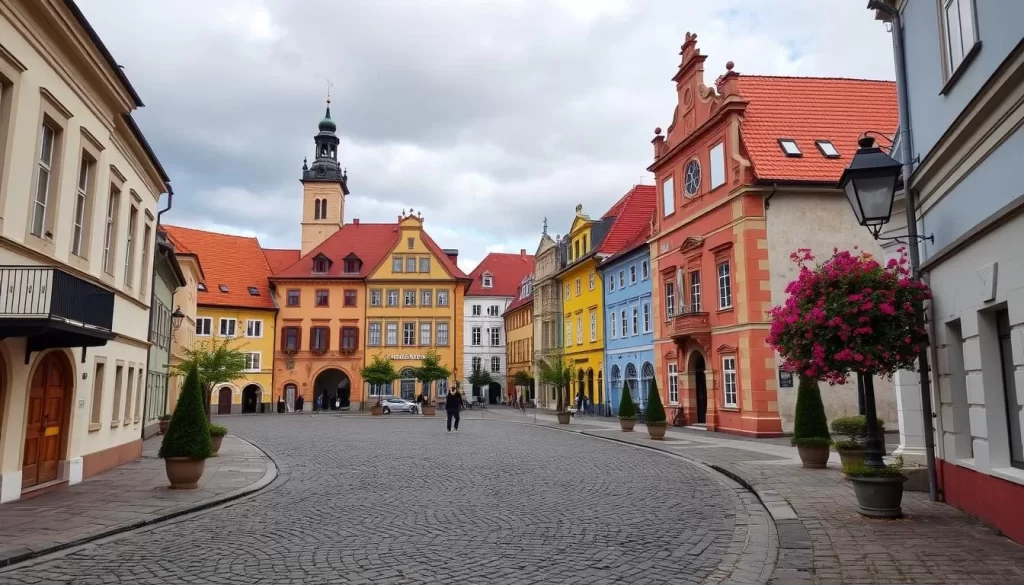
Architectural Highlights and Historic Buildings
Lublin’s Old Town is renowned for its well-preserved medieval layout and stunning architectural heritage. The area boasts an array of historic buildings, including remnants of the defensive walls such as the Cracow Gate, the Gothic Tower, and the Grodzka Gate. These structures not only highlight the city’s medieval past but also serve as iconic landmarks that attract visitors from around the world.
The Grodzka Gate, in particular, is a significant historical landmark that has witnessed the city’s evolution over the centuries. Its presence is a testament to Lublin’s rich history and cultural significance.
The Crown Tribunal and Underground Route
At the heart of the Old Town Square lies the Crown Tribunal, a building of immense historical importance. Once the highest court for the Polish nobility, it now houses a museum and offers guided tours. Beneath the Crown Tribunal is the Lublin Underground Route, a fascinating subterranean passage that provides insight into the city’s medieval past.
The Underground Route is an intriguing aspect of Lublin’s history, offering visitors a glimpse into the city’s development over the centuries.
Old Town Square and Surrounding Tenements
The Old Town Square is surrounded by colorful tenement houses, each with its own unique history and architectural details. One notable example is the Fortuna Cellar, a winery known for its unique frescoes. The square itself is a vibrant area, filled with cafes, restaurants, and cultural events throughout the year.
The Dominican Basilica, located nearby, is another significant landmark. Honored with the European Heritage Label for its connection to the Polish-Lithuanian Union of 1569, it stands as a testament to the city’s rich religious and cultural heritage.
As you explore Lublin’s Old Town, you’ll discover that it’s not just a collection of historical buildings but a living, breathing part of the city. The area transforms with the seasons, from lively summer gardens to beautifully illuminated streets in winter. Po Farze Square is a popular meeting place, offering stunning views of Lublin Castle, which is uniquely situated outside the Old Town walls.
Lublin Castle: A Journey Through Time
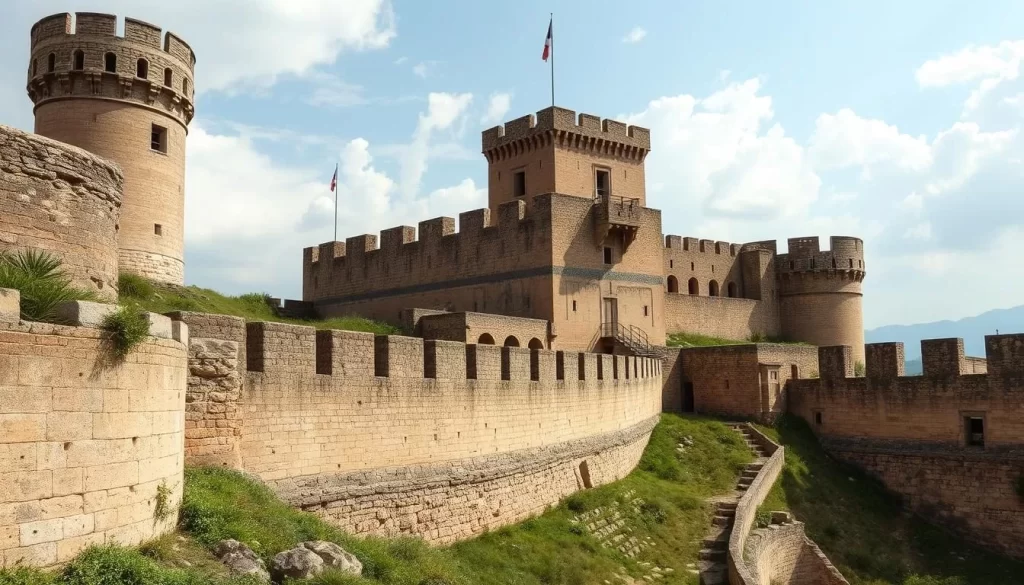
As you step into Lublin Castle, you’re not just entering a historical site; you’re embarking on a journey through time. This iconic landmark, originally built in the 12th century, has been reconstructed multiple times, reflecting the various architectural styles and historical periods it has traversed.
The Medieval Donjon Tower
The Medieval Donjon Tower, a standout feature of Lublin Castle, is an imposing structure that commands attention. Standing 20 meters tall with walls up to 4 meters thick, it was built during the reign of Casimir the Great, serving as a defensive stronghold. Today, it houses an exhibition on the castle’s history, and visitors can climb to the top for a panoramic view of the Old Town.
National Museum Collections
The National Museum within Lublin Castle is a treasure trove of historical artifacts, showcasing the rich cultural heritage of the region. The collections range from archaeological finds like stone tools and Roman coins to fine art and historical items that document Lublin’s past.
Among the museum’s most significant pieces is a massive 13-square-meter painting by Jan Matejko commemorating the Lublin Union of 1569. This artwork is not only a masterpiece of Polish art but also a window into the historical events that shaped the region.
The Famous Matejko Painting and Devil’s Paw
In addition to the Matejko painting, the museum also features the intriguing Devil’s Paw, a table with a burned mark that adds a touch of mystery to the castle visit. The legend surrounding this artifact contributes to the castle’s allure, making it a fascinating place to explore.
Lublin Castle’s location outside the Old Town walls provides a unique perspective on the city’s historical development and defensive strategy. As you explore the castle, you gain insights into the diverse cultural influences that have shaped Lublin throughout its history, from medieval Polish to Renaissance and later periods.
To make the most of your visit, consider the best times to avoid crowds. Early morning or late afternoon visits can provide a more serene experience, allowing you to fully appreciate the historical significance and beauty of Lublin Castle.
The Trinity Chapel: Gothic Exterior, Byzantine Interior
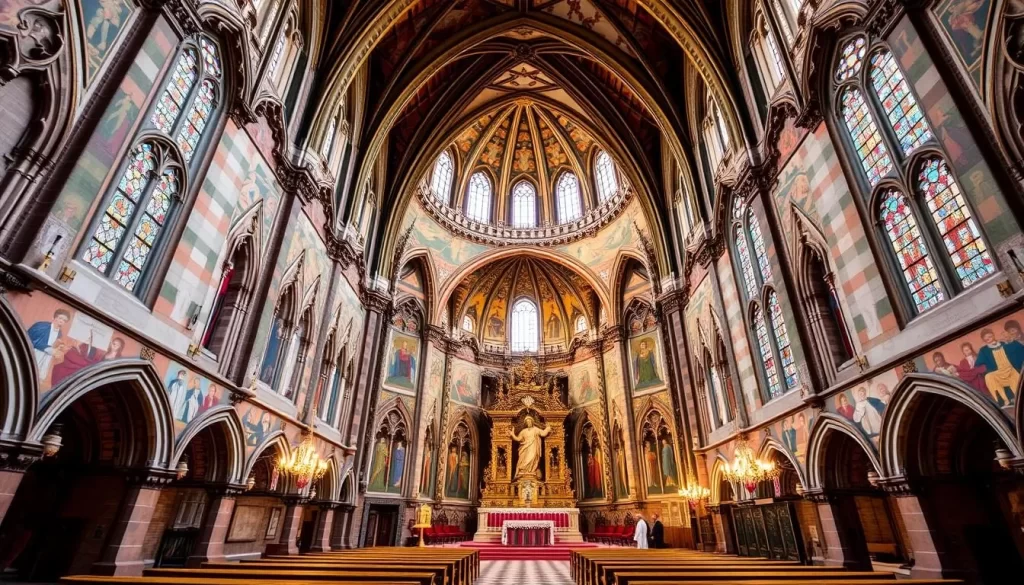
Hidden within Lublin’s Old Town is the breathtaking Trinity Chapel, a site that seamlessly merges Gothic exterior elegance with Byzantine interior splendor. This 14th-century chapel is a must-see place in Lublin, attracting visitors from around the world with its unique architectural fusion.
The Trinity Chapel’s history dates back to the 14th century, a time when Lublin was a significant cultural and trade hub. Its architectural uniqueness lies in the blend of Gothic and Byzantine styles, representing the meeting point of Eastern and Western Christian traditions in medieval Poland.
Byzantine-Ruthenian Frescoes
The interior of the Trinity Chapel is adorned with breathtaking Byzantine-Ruthenian frescoes, painted in 1418. These frescoes, remarkably preserved for over 600 years, cover nearly every surface inside the chapel, including the walls and ceiling.
The frescoes depict numerous archangels and saints, showcasing vivid colors and intricate details that highlight the artistic skill of the medieval painters. The frescoes are not only a testament to the artistic heritage of the time but also provide valuable insights into the religious and cultural practices of the period.
King Władysław Jagiełło’s Legacy
Among the frescoes, a rare portrait of King Władysław Jagiełło can be found. This contemporary depiction of the important Polish monarch is one of the few surviving images from that era, making it a significant historical find.
The Trinity Chapel has been honored with the European Heritage Label, recognizing its exceptional cultural and historical value. This recognition underscores the chapel’s importance as a historical site and a symbol of Lublin’s rich cultural heritage.
When visiting the Trinity Chapel, it’s essential to allocate sufficient time to fully appreciate the artistic details and historical significance of this remarkable space. Visitors can explore the chapel through guided tours, which provide deeper insights into its history and architectural uniqueness.
Practical information for visitors includes checking the opening hours and photography policies. The chapel is a popular destination, and understanding these details can enhance your visit.
Religious Heritage of Lublin
The religious heritage of Lublin is a fascinating blend of art, history, and faith, evident in its many churches and sacred buildings. As you wander through the old town, you’ll be struck by the architectural diversity and the historical significance of these religious sites.
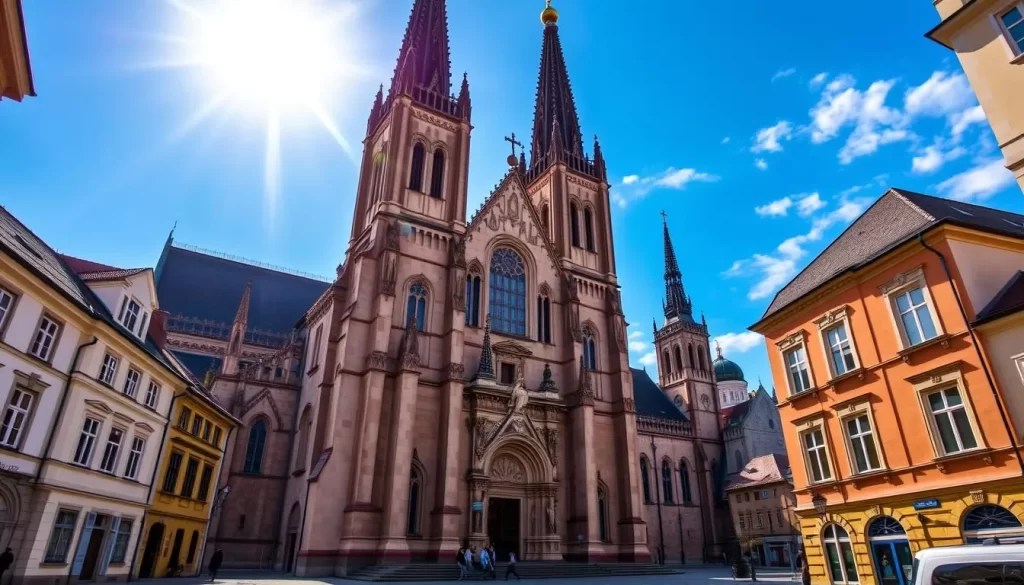
The Dominican Basilica
The Dominican Basilica stands out as one of Lublin’s oldest and most important churches, connected to the Polish-Lithuanian Union of 1569 and recognized with the European Heritage Label. This historic church is a testament to the city’s rich religious and cultural heritage.
The basilica’s architecture and interior decorations reflect the multicultural influences that have shaped Lublin over the centuries. Visitors can explore the church’s impressive structure and learn about its historical significance.
St. John’s Cathedral and Its Treasures
St. John’s Cathedral is another significant religious site in Lublin, renowned for its stunning Meyer’s illusionist polychromy. This artistic masterpiece is designed to inspire religious devotion through its visual beauty, making it a must-see for visitors.
The cathedral houses several remarkable treasures, including an altar made of black pear wood, a 14th-century baptismal font, and the historic cross from the Lublin Tribunal. Visitors can also explore the Acoustic Sacristy and the crypts, each offering a unique glimpse into the cathedral’s history and significance.
The Trinitarian Tower and Archdiocese Museum
Nearby, the Trinitarian Tower offers a panoramic view of the city from 40 meters above the ground, accessible by climbing 207 steps. According to legend, the tin rooster at the tower’s top once warned the inhabitants of impending danger.
The tower is also home to the Archdiocese Museum of Sacred Art, which showcases a collection of religious artifacts and artwork from throughout Lublin’s history. This museum provides a deeper understanding of the city’s religious heritage and its cultural identity.
Lublin’s religious sites are not just places of worship; they are also repositories of history, art, and culture. As you explore these sites, you’ll gain a deeper appreciation for the city’s complex past and its multicultural identity.
Litewski Square: The Heart of Lublin
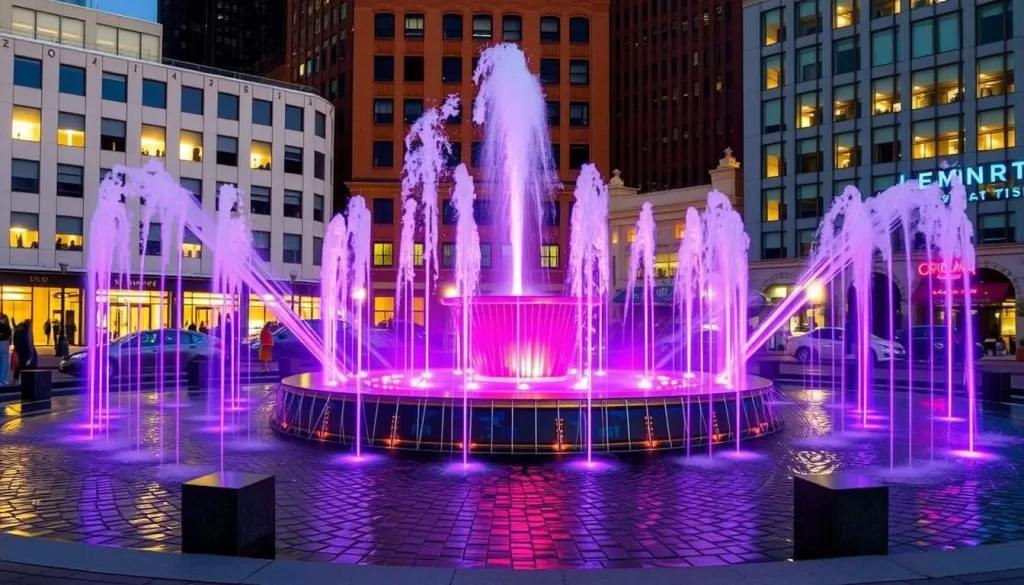
Litewski Square is the vibrant heart of Lublin, pulsating with life and energy. This central place is where locals and tourists alike gather to relax, socialize, and enjoy the city’s atmosphere. The square is beautifully landscaped with greenery, fountains, and numerous benches, making it a popular spot to unwind.
The Multimedia Fountain and Evening Shows
The centerpiece of Litewski Square is its modern multimedia fountain, which comes alive with colorful displays after dark. During the summer months, from May to September, you can enjoy spectacular evening shows that combine water, light, and sound in a unique spectacle. These shows are not just entertaining; they also tell stories about Lublin’s history and legends, adding a layer of cultural depth to the experience.
If you visit Litewski Square during one of these evening shows, you’ll likely want to come back again and again to relive the magic. The harmony of water, light, and sound creates a truly unforgettable experience.
Historical Monuments and Surrounding Architecture
Litewski Square is also home to several significant historical monuments. You can find tributes to important figures and events, such as the Monument to Józef Piłsudski, the Constitution of May 3, the Unknown Soldier, and an obelisk commemorating the Union of Lublin, which bears the European Heritage Mark. These monuments add a rich historical layer to the square, making it a fascinating place to explore.
The square is surrounded by beautiful old buildings and palaces, including the Capuchin Church, which add to the architectural interest of the area. The blend of old and new creates a unique and captivating atmosphere, making Litewski Square a must-visit destination in Lublin’s city center.
As you stroll through Litewski Square, you’ll also discover family-friendly amenities such as chess tables and playgrounds with Lublin-themed elements, like wooden billy goats. The square’s greenery and open spaces make it an ideal spot for families and those looking to enjoy the outdoors.
To fully experience Litewski Square, visit at different times of day. From peaceful morning strolls to lively evening gatherings around the illuminated fountain, the square offers a changing atmosphere that is sure to captivate. Nearby cafés and restaurants provide the perfect opportunity to people-watch while enjoying refreshments in this central place.
Cultural Centers and Performance Venues
You can experience the best of Lublin’s culture by visiting its two major cultural hubs. Lublin’s cultural landscape is enriched by historical and modern venues that host a variety of performances and events.
Centre for Culture in the Old Monastery
The Centre for Culture, housed in an old monastery, is a testament to Lublin’s ability to blend the old with the new. This cultural institution is home to various artistic and cultural organizations, including Dosłowna Bookshop, Galeria Biała, Galeria ArtBrut, and the Centre for Intercultural Creative Initiatives “Crossroads”. The center buzzes with life, hosting concerts, theatrical performances, film screenings, and workshops for all ages. It’s also the headquarters for several of Lublin’s major cultural festivals, such as the Theatre Confrontations International Festival and Lublin Jazz Festival.
Cultural Events and Performances are at the heart of the Centre for Culture. With its diverse programming, it caters to a wide range of interests and age groups. The presence of a cinema, Lublin Dance Theatre, and regular meetings for children and teenagers make it a vibrant cultural hub.
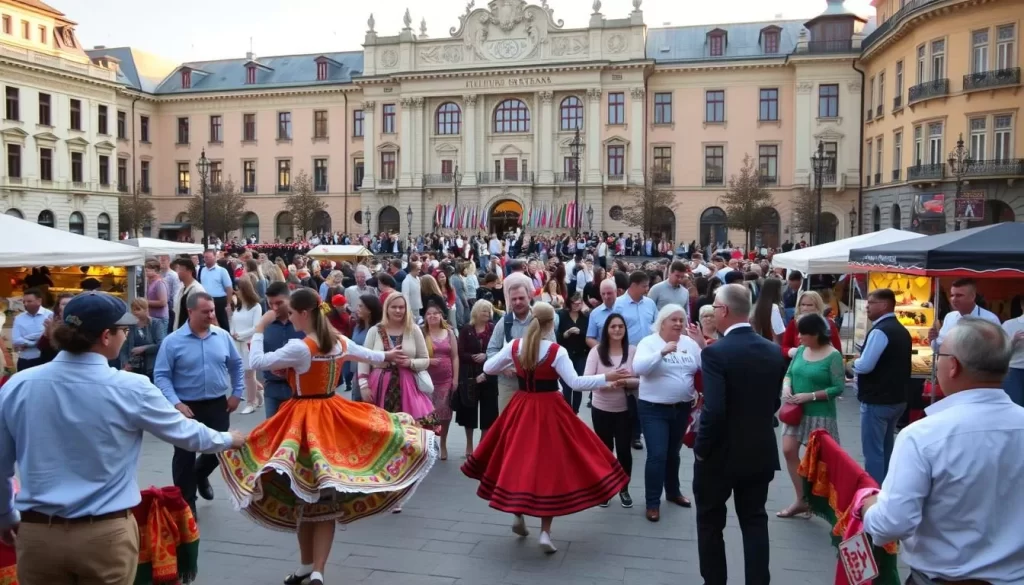
Center for the Meeting of Cultures
In contrast to the historical ambiance of the Centre for Culture, the Center for the Meeting of Cultures represents modern architecture. Designed by Bolesław Stelmach, this center is a minimalist masterpiece with an industrial interior. It houses the Musical Theatre, Lublin Philharmonic, Hans Christian Andersen Theatre, and the Brain Damage Gallery, which is dedicated to graffiti art.
The center is not just about performances; it’s also a place for cultural exchange and learning. The rooftop garden is a unique feature, with plants typical of the Lublin region, beehives, and the Municipal Artistic Apiary. This blend of urban culture and agricultural tradition is a standout feature of the center.
| Cultural Institution | Features | Events/Performances |
|---|---|---|
| Centre for Culture | Old Monastery, various cultural organizations | Concerts, theatrical performances, film screenings, workshops |
| Center for the Meeting of Cultures | Modern architecture, industrial interior | Musical Theatre, Lublin Philharmonic, Hans Christian Andersen Theatre performances, graffiti exhibitions |
Both cultural centers offer a unique perspective on Lublin’s cultural identity, blending historical significance with modern creativity. As you explore these venues, you’ll gain a deeper understanding of the city’s vibrant cultural scene.
Jewish Heritage Sites in Lublin
Exploring Lublin’s Jewish heritage sites is a journey through the history of a community that played a vital role in shaping the city’s identity. Lublin was once home to a thriving Jewish population, and the sites that remain today offer a poignant glimpse into the lives of the people who lived there.
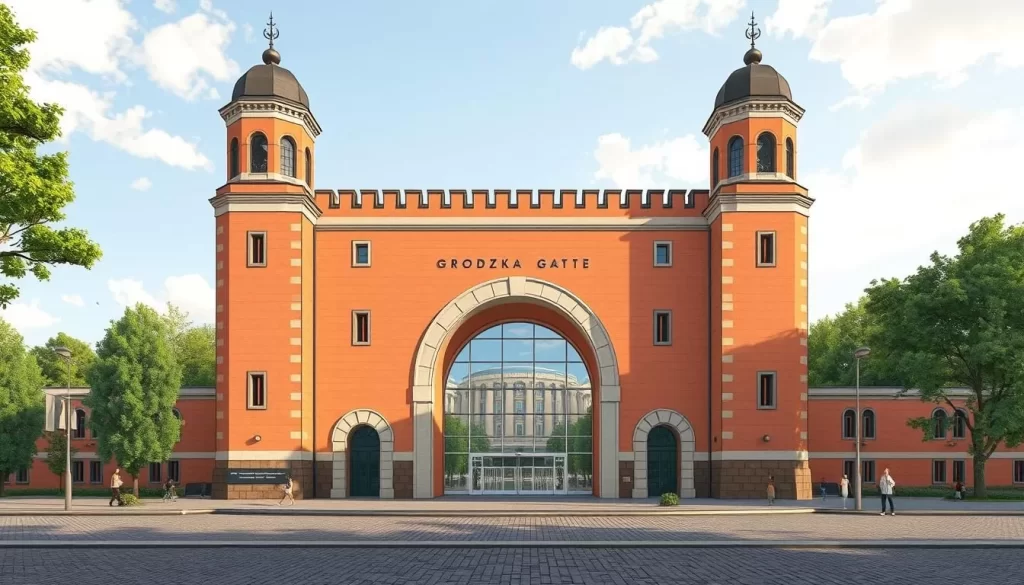
Grodzka Gate – NN Theater Center
The Grodzka Gate – NN Theater Center is a primary institution preserving the memory of Jewish Lublin. Housed in the historical gateway between the Christian and Jewish quarters, the center offers moving exhibitions that include virtual reconstructions of streets that no longer exist.
The exhibition entitled “Lublin. Memory of the Place” documents the last decades before the Holocaust, providing a glimpse into the intellectually, culturally, and economically vibrant Jewish community that once thrived in Lublin.
Yeshiva Chachmej Lublin and Synagogues
The Yeshiva Chachmej Lublin, or Lublin School of Sages, was once the world’s largest and most prestigious Talmudic school. Today, it houses a synagogue and museum, serving as a significant site for understanding the historical importance of Jewish education in Lublin.
Other important sites include the Chevra Nosim Synagogue and the Old Jewish Cemetery (Kirkut) with the ohel (tomb) of the famous “Seer of Lublin.” These sites are crucial in understanding the religious and cultural practices of Lublin’s Jewish community.
The Memory Lantern and Trail of Remembrance
Near the Grodzka Gate, the Memory Lantern stands as an eternal flame commemorating Lublin’s Jewish citizens who perished during the Holocaust. This poignant monument serves as a reminder of the devastating impact of World War II on the Jewish community.
The “Trail of Remembrance of the Lublin Jews” guides visitors through sites of Jewish significance throughout the city, helping to preserve the memory of a community that was nearly erased.
By visiting these sites, you can gain a deeper understanding of Lublin’s complex history and the significant contributions of its Jewish community to the city’s cultural and economic identity.
State Museum at Majdanek: Preserving Difficult History

As you visit the State Museum at Majdanek, you are stepping into a place of profound historical significance and somber reflection. Established in 1944, it is Europe’s oldest museum commemorating the victims of World War II, located on the grounds of the former Nazi concentration and death camp.
The museum spans across 90 hectares, preserving approximately 70 historical objects, including prisoner barracks, guard towers, and the crematorium. These structures serve as a poignant reminder of the atrocities committed during World War II.
Historical Significance and Exhibitions
The State Museum at Majdanek is not just a collection of historical buildings; it is a repository of memory and a place of education. The museum houses powerful permanent exhibitions that detail the history of the camp and the experiences of its prisoners. One of the most impactful exhibitions is the multimedia “Prisoners of Majdanek” in Barracks No. 62, which tells the stories of those who suffered and died here.
The museum also preserves the memory of victims from various nationalities, with a special emphasis on the Jewish victims of the Holocaust. The camp played a significant role in the “Operation Reinhardt” genocide, and this dark history is meticulously documented and presented to visitors.
Educational Programs and Commemoration
The museum offers important educational programs that teach visitors about the German occupation of the Lublin region during World War II and the broader historical context. These programs are designed to educate future generations about the dangers of totalitarianism and hatred.
Commemoration ceremonies are held at the site, particularly at the massive memorial mausoleum containing the ashes of victims. These events serve as a reminder of the importance of preserving memory and promoting historical education.
Visitors are encouraged to approach this difficult but important historical site with respect and reflection. The museum’s mission is not only to preserve the memory of those who suffered but to serve as a warning for future generations.
Open Air Village Museum: Rural Life Preserved
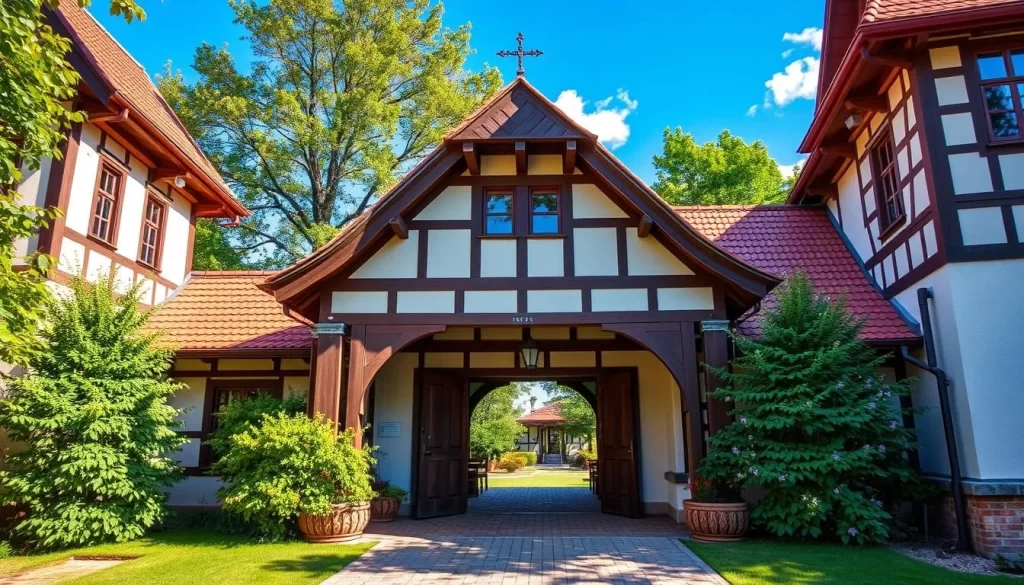
Step into the Lublin Open Air Village Museum, where the past comes alive in a sprawling green landscape. This unique cultural destination offers a glimpse into rural Polish life from centuries past, spread across expansive grounds.
The museum is a living time capsule, featuring over 40 carefully reconstructed traditional buildings, including thatched cottages, workshops, a school, churches, and windmills. These structures are arranged to recreate the atmosphere of a historic village, allowing visitors to experience authentic rural life.
Traditional Architecture and Interiors
The museum’s collection includes a variety of traditional buildings, each furnished with period-appropriate interiors, agricultural implements, and household items. These exhibits illustrate daily rural life in the Lublin region throughout history, providing a unique insight into the lives of the people who lived there.
Visitors can explore the thatched country cottages, visit old workshops in a provincial town, and see traditional agricultural practices up close. The museum’s attention to detail and commitment to authenticity make it a fascinating destination for anyone interested in history and culture.
Seasonal Events and Cultural Demonstrations
The Lublin Open Air Village Museum follows the seasons, with different activities and demonstrations taking place throughout the year. Harvest festivals, haymaking demonstrations, traditional dances, and folk music performances bring the village to life, showcasing the rich cultural heritage of the region.
Visitors can experience the changing face of rural life by visiting during different seasons. From spring planting to summer harvests and winter celebrations, the museum offers a unique perspective on the traditional agricultural calendar. The on-site inn serves traditional dishes prepared using historic recipes and methods, allowing visitors to taste authentic regional cuisine.
The museum is open all year round, making it accessible regardless of when you visit Lublin. While the range of outdoor activities varies with the seasons, there’s always something to see or experience at the Lublin Open Air Village Museum.
Natural Escapes in and Around Lublin
Lublin is a city that offers a unique blend of history, culture, and natural beauty. You can experience the best of both worlds in Lublin, where historical sites are complemented by picturesque natural escapes. Whether you’re looking to relax, engage in outdoor activities, or simply enjoy the scenery, Lublin has something for everyone.
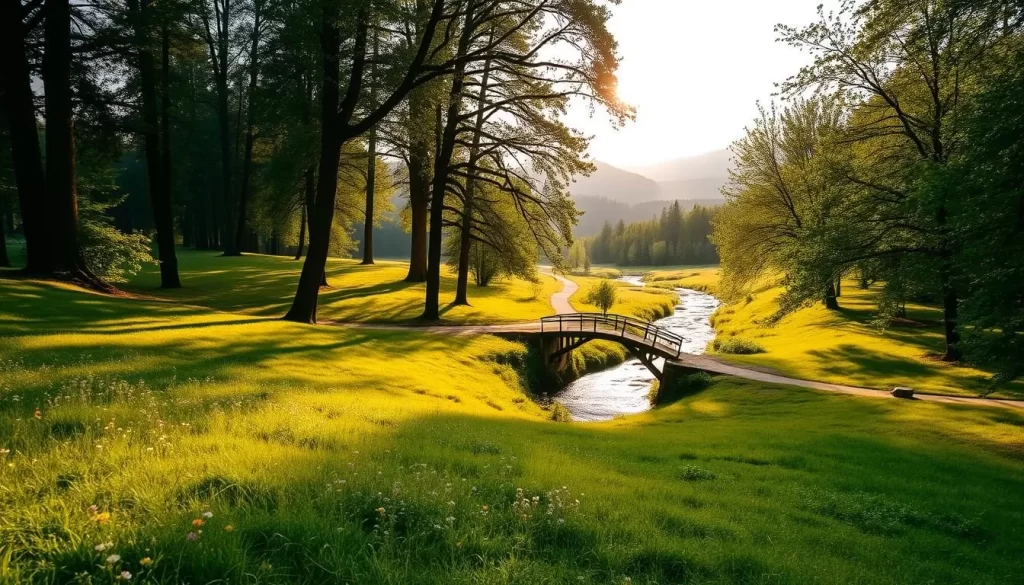
Lublin Botanical Garden
The Lublin Botanical Garden of UMCS is a serene oasis in the heart of the city. With over 1,600 species of trees and shrubs, more than 3,300 herbaceous plants, and around 1,600 species of greenhouse plants, it’s a haven for nature lovers. As you stroll through the garden, you’ll come across large hundred-year-old trees, the historic Kościuszko Manor House, and a charming café hidden among the greenery. The garden is open to visitors from April to the end of October, making it a perfect open-air destination for spring and summer days.
Zemborzyce Lake and Recreational Activities
For those who enjoy spending time by the water, Zemborzyce Lake is a favorite spot. The lake offers a sandy beach for sunbathing, green areas for picnics or grilling, and a range of recreational activities. The surrounding Dąbrowa forest complex provides a beautiful backdrop for walks and hikes. In the summer, the Słoneczny Wrotków complex comes alive with water attractions, including pools, slides, and paddling pools for children. You can also rent water equipment, try water skiing, or go canoeing on the Bystrzyca river.
A 12 km long bicycle path circles the reservoir, making it a great spot for cycling. Whether you’re looking for relaxation or adventure, Zemborzyce Lake has something to offer. You can simply walk, pick fried fish, and enjoy the peaceful surroundings, making it an ideal place to unwind.
Parks and Green Spaces in the City
Lublin’s urban parks and green spaces provide peaceful retreats within the city. The historic Saxon Garden is one such haven, offering a tranquil atmosphere and beautiful scenery. These green spaces are perfect for a leisurely stroll or a picnic, allowing you to take a break from the hustle and bustle of city life.
Visiting these natural attractions is a great way to experience the best of Lublin. Whether you’re interested in botany, outdoor activities, or simply enjoying the fresh air, Lublin’s natural escapes are sure to delight. So, take a path less traveled and discover the natural beauty of Lublin.
Lublin, Poland: Best Things to Do for Food Lovers
As you explore the historic streets of Lublin, you’ll uncover a rich culinary scene that reflects the city’s diverse heritage. Lublin’s cuisine is a testament to its multicultural history, blending traditional Polish flavors with influences from Jewish, Ukrainian, and other Eastern European culinary traditions.
Traditional Polish Cuisine in Lublin
Lublin’s culinary identity is deeply rooted in traditional Polish cuisine, with dishes that have been passed down through generations. Some must-try local specialties include cebularz (onion bread), forszmak lubelski (savory stew), and regional variations of pierogi. These dishes are often made with locally sourced ingredients from the fertile agricultural region surrounding the city, highlighting the farm-to-table aspect of Lublin’s culinary culture.
The city’s restaurants take pride in serving authentic Polish cuisine, often accompanied by live folk music performances that enhance the dining experience. Visitors can enjoy these traditional meals in historic settings within the Old Town area, immersing themselves in the local culture.
Best Restaurants and Cafés
Lublin is home to a variety of restaurants and cafés that cater to different tastes and preferences. For those seeking traditional Polish cuisine, there are numerous eateries in the Old Town area that offer historic ambiance along with delicious meals. Some modern restaurants are also reinventing Polish classics with contemporary techniques, providing a fresh twist on traditional flavors.
The café culture in Lublin is thriving, with both historic establishments and trendy new spots serving excellent Polish cakes and pastries alongside specialty coffee. Visitors can enjoy a leisurely coffee or snack in a charming setting, taking a break from exploring the city.
| Restaurant/Café | Cuisine/Type | Location |
|---|---|---|
| Restaurant 1 | Traditional Polish | Old Town |
| Café 2 | Polish Pastries & Coffee | City Center |
| Modern Bistro | Contemporary Polish | Near Litewski Square |
Lublin also hosts seasonal food festivals and culinary events that showcase the region’s gastronomic heritage. These events provide unique dining experiences for visitors, offering a chance to sample local delicacies and drinks.
For American travelers, navigating Polish menus and dining customs can be made easier with a few tips. Understanding basic Polish phrases and being aware of local dining etiquette can enhance the culinary experience, allowing visitors to fully enjoy their dining adventures in Lublin.
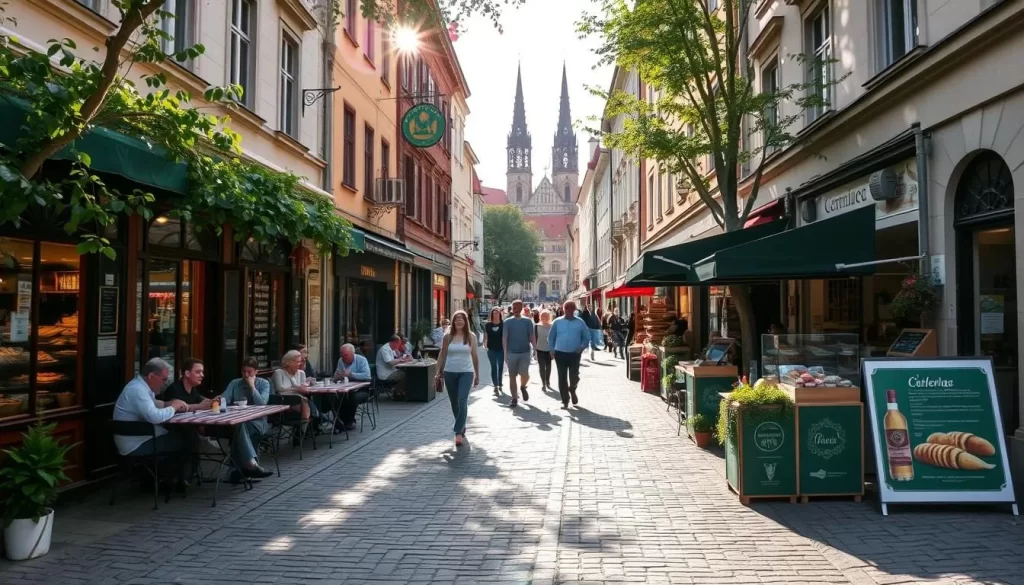
Cultural Events and Festivals in Lublin
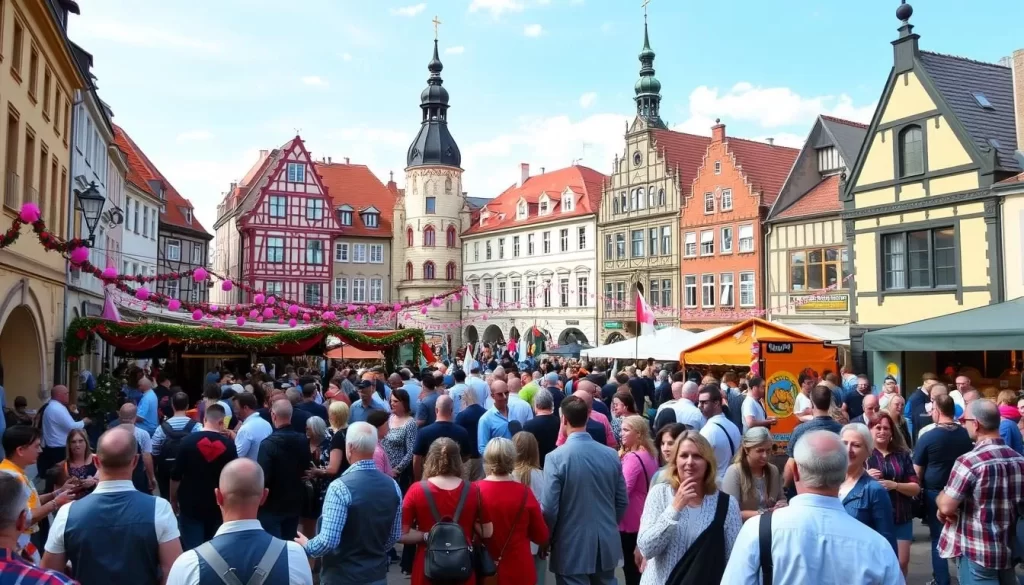
Lublin’s cultural calendar is packed with international festivals, music events, and seasonal celebrations that are sure to captivate you. As you explore this vibrant city, you’ll discover a rich cultural scene that reflects its unique blend of Eastern and Western European traditions.
Theatre Confrontations International Festival
The Theatre Confrontations International Festival is one of Eastern Europe’s most important theatrical events, bringing innovative performances from around the world to Lublin’s stages. This festival is a must-attend for theater enthusiasts, featuring a diverse range of productions that push the boundaries of contemporary theater. With performances taking place in various venues across the city, you’ll have the opportunity to experience the best of international theater.
Lublin Jazz Festival and Music Events
The Lublin Jazz Festival has been attracting world-class musicians and jazz enthusiasts for decades, with performances in various venues across the city. This festival is a celebration of jazz music in all its forms, from traditional to contemporary. You can enjoy live music performances in intimate settings, ranging from historic buildings to modern concert halls.
Seasonal Celebrations and Street Performances
Lublin’s summer season comes alive with street performances, open-air concerts, and artistic interventions that take advantage of the city’s beautiful historic settings. You can experience the city’s vibrant atmosphere during seasonal celebrations, which mark important Polish holidays and traditions. From Easter markets to Christmas festivities in the Old Town, there’s always something to look forward to.
Planning your visit around specific festivals can help you experience Lublin at its most vibrant and culturally rich moments. Be sure to check the city’s events calendar to stay informed about current cultural events during your visit. With its rich cultural heritage and diverse range of events, Lublin is a city that has something to offer for everyone.
Day Trips from Lublin
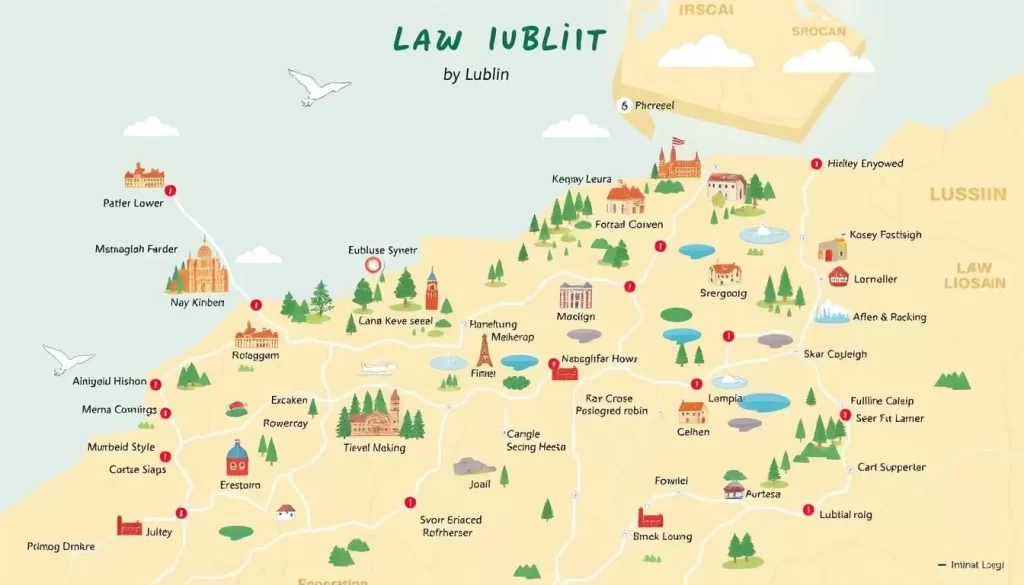
With its central location, Lublin makes an ideal starting point for day trips to some of Poland’s most intriguing towns and natural attractions. You can explore the beautiful destinations within easy reach of Lublin that make perfect day trips for visitors wanting to experience more of eastern Poland.
Kazimierz Dolny: The Artists’ Haven
Kazimierz Dolny is a picturesque town on the Vistula River that has attracted artists for generations with its Renaissance architecture, beautiful market square, and scenic river views. The town’s artistic atmosphere is palpable, with numerous galleries, studios, and cultural events that continue its tradition as a creative haven.
You can stroll through the charming streets, admire the historic buildings, and visit the many art galleries showcasing local and international artists. The town’s relaxed atmosphere makes it an ideal day trip destination from Lublin.
Zamość: The Ideal Renaissance Town
Zamość is a UNESCO World Heritage site designed as an “ideal Renaissance town” by Italian architect Bernardo Morando, with its perfectly preserved Old Town and distinctive arcaded buildings. The town’s historical significance is evident in its impressive fortifications and multicultural heritage, reflecting its past as a thriving trading center where Polish, Jewish, Armenian, and Greek merchants once converged.
As you explore Zamość, you’ll be struck by the town’s unique blend of architectural styles and its well-preserved historic core. It’s a fascinating day trip that offers a glimpse into Poland’s rich history.
Roztocze National Park: Nature at Its Best
Roztocze National Park is a natural paradise with diverse landscapes, including pristine forests, rolling hills, natural rock formations, and the clear waters of the Wieprz River. The park offers numerous hiking trails and natural attractions, such as the “Echo Ponds” and unique chalk formations, making it a geologically fascinating destination.
You can spend your days exploring the park’s many trails, enjoying the scenic views, and experiencing the beauty of Poland’s natural heritage. It’s an ideal destination for nature lovers and those seeking a relaxing day trip from Lublin.
In addition to these destinations, you may also consider visiting the Renaissance castle in Krasiczyn or the historical town of Chełm with its chalk tunnels. Lublin’s central location makes it easy to explore a variety of exciting places in eastern Poland.
Practical Information for Visiting Lublin
As you plan your trip to Lublin, Poland, it’s essential to have the right information at your fingertips to make the most of your visit. Lublin, with its rich history and vibrant cultural scene, is a city that promises an unforgettable experience. From getting to and around the city to choosing where to stay and when to visit, this section will provide you with all the practical information you need.
Getting to and Around Lublin
Lublin is accessible by air, train, and bus, making it relatively easy to reach from various parts of Europe and beyond. Lublin Airport is the primary airport serving the city, with connections to several European cities. For those traveling from within Poland or neighboring countries, train connections from major cities like Warsaw are frequent and convenient. Bus services also offer an affordable and relatively quick way to reach Lublin.
Once in Lublin, getting around is straightforward. The city boasts an efficient bus network that covers most areas of interest. For tourists, the central areas are also very walkable, making it easy to explore the city’s main attractions on foot. Taxis are readily available, and ride-hailing services are also an option for shorter trips.
| Transportation Method | Details | Approximate Cost |
|---|---|---|
| Lublin Airport to City Center | Bus or Taxi | $10-$20 |
| Train from Warsaw | Frequent services | $20-$50 |
| Bus Services | From various Polish cities | $10-$30 |
Where to Stay: Accommodation Options
Lublin offers a wide range of accommodation options to suit different budgets and preferences. From luxury hotels in beautifully renovated historic buildings to boutique guesthouses in the heart of the Old Town, there’s something for everyone. For budget travelers, affordable hostels provide a convenient and social way to stay in the city.
The Old Town is the most convenient area to stay, offering proximity to main attractions and a vibrant atmosphere, especially in the evenings. However, it’s worth considering that staying in the Old Town can be more expensive than areas slightly further out. Neighborhoods like Kalwaria or Zemborzyce offer alternative accommodation options with easier access to the city center via public transport.
Best Time to Visit and Seasonal Considerations
The best time to visit Lublin is from May to September, when the weather is pleasant, and the city hosts various outdoor cultural events and festivals. Summer is a great time to enjoy the restaurant gardens in the Old Town and the city’s parks. For those who enjoy winter landscapes, December is a lovely time to visit, with Christmas markets and the city’s winter illuminations.
Each season has its charm: spring brings beautiful blooms, autumn offers colorful foliage in the parks, and winter can be magical with its snow-covered landscapes. However, it’s worth noting that winter snow can sometimes affect travel plans.
Useful Tips for American Travelers
For American travelers, a few practical tips can make a big difference. First, while many Lublin residents, particularly younger people, speak some English, it’s still a good idea to learn a few basic Polish phrases. Currency exchange is straightforward, with many offices and banks offering competitive rates. Be aware that not all places accept credit cards, so it’s a good idea to have some cash on hand.
When it comes to electrical adapters, Poland uses Type E/F plugs, with a standard voltage of 230V. Tipping in restaurants and bars is generally around 10%, similar to practices in the US. Lastly, Lublin is considered a safe city, but as with any travel, taking normal precautions to protect your belongings is advisable.
Why Lublin Should Be on Your Polish Itinerary
With its rich history, cultural treasures, and warm hospitality, Lublin is a hidden gem waiting to be discovered in eastern Poland. As you explore this charming city, you’ll uncover the authentic spirit of Poland, far from the crowds that often flock to more popular destinations.
Lublin’s Old Town is one of Poland’s best-preserved, offering a glimpse into the country’s medieval past. The city’s historical significance is palpable, from its role in the Polish-Lithuanian Commonwealth to its impact on modern Polish history. You’ll find that Lublin’s history is alive and well, woven into the fabric of its architecture, museums, and cultural events.
When it comes to experiencing Polish cuisine, Lublin is a city that will delight your senses. With a variety of restaurants serving traditional dishes, you’ll have the opportunity to taste the local flavors without breaking the bank. Compared to Poland’s more famous cities, Lublin offers exceptional value for travelers, with lower prices for accommodations, dining, and activities.
The city’s cultural richness is evident in its numerous theaters, museums, and festivals. Lublin’s vibrant arts scene continues to evolve, honoring traditions while embracing modern creativity. As you immerse yourself in the local culture, you’ll appreciate the warm hospitality of Lublin’s people, making your visit even more memorable.
For travelers, a stay of 2-4 days is ideal to explore Lublin’s many attractions. You can also combine Lublin with other destinations in eastern Poland for a comprehensive regional experience. As you plan your trip, consider the best time to visit and how to get around the city to make the most of your time.
As you conclude your visit to Lublin, you’ll likely find yourself planning to come back. The city’s unique charm and many layers have a way of captivating visitors, leaving a lasting impression. With its rich history, cultural treasures, and welcoming atmosphere, Lublin is a place that stays with you, inviting you to return and explore further.
